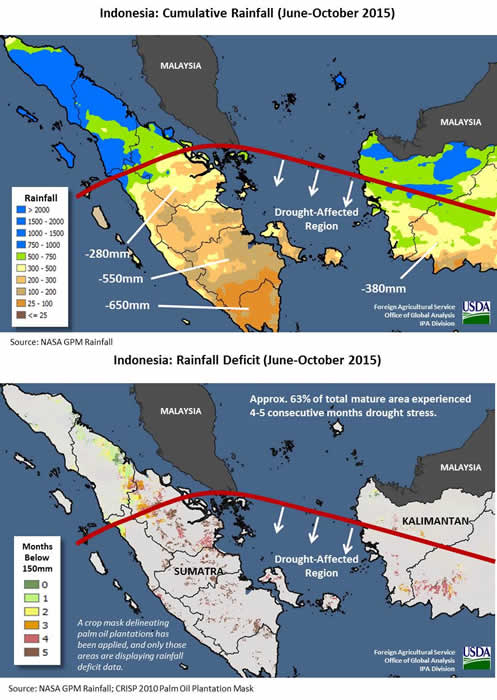INDONESIA: Palm Oil Production Prospects Dampened by El Niño Drought

USDA forecasts 2015/16 palm oil production in Indonesia at a record 33.0 million tons, down 2.0 million tons from last month's forecast but unchanged from last year. Total area devoted to oil palm plantings is estimated at a record 10.8 million hectares, with mature “harvested” area at 8.97 million hectares. Mature area is forecast to increase roughly 5 percent compared to last year, or 425,000 hectares. Crop yield is forecast at 3.68 tons per hectare, down approximately 5 percent from last year.
The current strong El Niño weather pattern has suppressed rainfall over a wide swath of southeastern Asia during the northern hemisphere summer in 2015. Rainfall in Indonesia’s prime palm oil growing areas on the islands of Sumatra and Kalimantan was well below normal for a 5-month period from June-October 2015. The resulting drought stress is expected to cause modest crop yield declines during the current USDA 2015/16 marketing year (October 2015 through September 2016). Palm oil yields typically decline 4-12 months after a stress event has occurred.
Oil palm trees are moisture sensitive in general and are primarily adapted to tropical regions with consistent year-round temperatures and rainfall. To yield normally, oil palms require between 150-200 millimeters of rainfall each month. This equates to roughly 2000-2500 millimeters per year. The trees can withstand short drought periods, depending on the soil type and underlying water table. Drought stress lasting more than 8 weeks, however, usually results in reduced flowering and fruit production during the following 12 month period. Yield reductions can reach 30 percent following very severe drought situations.

Rainfall in the drought-affected regions of Indonesia averaged between 280-650 millimeters below required levels during the entire 5-month period. This equates to rainfall being 40-87 percent below the minimum needed to sustain normal yields. It is estimated that roughly 63 percent of total mature acreage in Indonesia experienced 4-5 consecutive months of drought conditions between June and October 2015.
New oil palm area has been increasing at a rate between 300,000-500,000 hectares per year, while mature harvested area has grown by an average of 400,000 hectares per year for the past ten years. Oil palm is mature when the tree is three years old. Approximately 50 percent of total palm oil area is sown with trees that are less than 10 years old. These trees are new higher-yielding varieties that are reportedly more resilient to drought than those cultivated a decade or two ago, and are expected to experience less severe yield declines in 2015/16 than occurred in 1997/98. It should also be noted that the current drought intensity in 2015 is much less severe than at the same point in 1997. Indonesian oil palm trees, therefore, have experienced less severe moisture stress than in 1997. Palm oil yields declined approximately 20 percent in 1997/98 as a result of El Niño-induced drought.

Forecasts from major international meteorological organizations indicate that the current El Niño will peak in early 2016 and weaken during the northern hemisphere spring. USDA’s Agricultural Counselor’s office in Jakarta reports that as a result of recent drought, palm oil production declines are expected to first appear in December 2015 and linger throughout 2016. They also reported that field observations indicate that although drought is driving down yields, declines are mitigated by regional weather variations, improved cultivar varieties since the 1997/98 drought, and young plantations reaching maturity. Oil palm planting data indicates that new plantings reached near-peak levels of 800,000 hectares in 2013, implying that overall production will continue to rise as new plantations reach full maturity. Indonesian palm oil industry sources confirmed to USDA/Jakarta that production declines in 2016 are expected to be stronger than typically occur following the dry season, however, they stress that losses are not on par with yield declines experienced in 1997/98.
This report has been published by the Office of Global Analysis (OGA), International Production Assessment Division (IPAD). Current USDA area and production estimates for grains and other agricultural commodities are available on IPAD's Agricultural Production page or at PSD Online.
Related Links at FAS
PSD Online
http://apps.fas.usda.gov/psdonline/psdQuery.aspx
Crop Explorer
Crop Explorer http://www.pecad.fas.usda.gov/cropexplorer/
|

